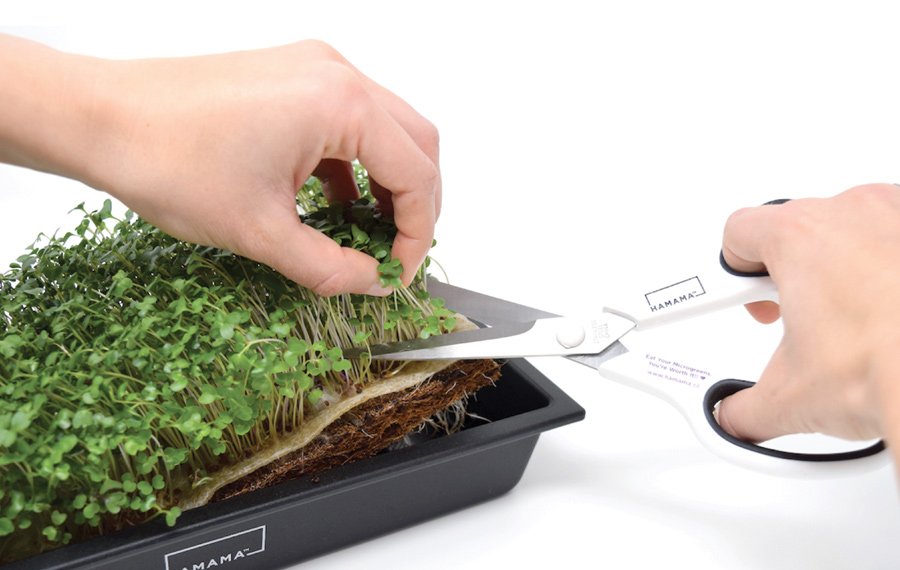
Have you noticed that the fancier the restaurant, the larger the plates and the smaller the food? In recent years, if the lighting is subtle and there is a white tablecloth, you’re sure to find a garnish of tiny baby plants atop at least one of your courses. And unlike many restaurant trends — foams and brussels sprouts, your time has passed — the microgreen craze of recent years turns out to be a really good thing.
Microgreens and herbs are essentially 7- to 10-day-old versions of leafy greens and vegetables that have been recognized as up to 40 times more nutritious and denser in vitamins and minerals than their more mature versions. Numerous studies have shown that microgreens pack a hefty nutritional punch of vitamins such as C, E, K and even lutein and beta-carotene, two antioxidants that are thought to stave off macular degeneration.
Like the full-grown versions of greens and vegetables, miniscule microgreens vary in flavor and nutrient content, but unlike their older siblings, it doesn’t take much convincing for anyone to love eating them — even kids. They’re colorful, ranging from vibrant green to purple, delicate yet intensely flavorful, and they provide textural contrast in salads and sandwiches.
So, if microgreens are so tasty and good for you, why do they remain the purview of fancy restaurants, cafes and chefs’ tables and why isn’t everyone eating them?
First of all, microgreens can be difficult to find. Even though they are far more popular now than they once were, they’re not available everywhere and certainly not at any time of the year. Also, depending on the variety, even if you can find them in a well-stocked grocery store, a flat of microgreens could cost up to $30, while even a small bag of them in a health food store, enough for only a few salads or garnishes, is generally at least $6 to $10. And, on top of the high price and potential lack of availability, the delicate greens are
likely to go bad quickly on supermarket shelves and due to humidity in the packaging could even be a breeding ground
for bacteria and mold.
Luckily for microgreen fans, two MIT-educated engineers developed a solution: grow your own. Camille Richman and her co-founder Daniel Goodman met as researchers at the MIT Media Lab, where they were building and operating large-scale, indoor, controlled-environment farms growing a variety of crops year-round in Boston. Both got excited about the power and potential of indoor agriculture to provide fresh produce to folks no matter where they lived or what the season. The pair worked on the “Food Computer” project, a small-scale version of these farms where they ported various climates into greenhouses in order to see the effects on the crops.
According to Richman, the idea was to be able to crowdsource data on what environments induce various changes in crops such as volume, flavor and appearance. Working on that project got Richman and Goodman excited about smaller-scale, hyper-localized food production and taking advantage of the relatively controlled environments in homes to produce food where it’s going to be eaten, year-round, conveniently and affordably. Three years ago in Sacramento, they started their own company called Hamama to make that happen.
Born out of a stint working in Israel while she was a student at MIT, Richman first encountered the word “hamama” at Kibbutz Ein Shemer, where she started a program through MISTI (MIT International Science and Technology Initiative) to send MIT students to the kibbutz every year. The objective of the program, where Richman was a guest educator, was to work with Israeli middle and high school students on ecological problems affecting the region through hands-on projects in aeroponics and hydroponics, 3-D printing and biology. Hamama means “greenhouse” in Hebrew, “bird” in Arabic and “open” in Hawaiian (there is a Hamama Falls in Hawaii).
Numerous studies have shown that microgreens pack a hefty nutritional punch of vitamins such as C, E, K and even lutein and beta-carotene.
After returning from Israel, Richman and Goodman invented and patented a unique invention called a seed quilt, an all-natural, coconut-fiber base with various seeds embedded within a paper cover that enables microgreens to effortlessly be grown at home. The beauty of the seed quilt is that it takes care of all the environmental controls passively, without the need for any complex equipment. All customers have to do is add water once (the kit comes with a planting box with a designated water “fill line”), place a seed quilt in the water, and, in a week, start to harvest microgreens like broccoli, kale, radish, salad mix, arugula and others.
Hamama’s seed quilts do all the work of growing microgreens by controlling the watering, humidity and light. The quilt wicks up water gradually throughout the week so you don’t even have to remember to water. The paper cover blocks light access at the start, when the seeds require more darkness during the germination phase, after which the seedlings push up the paper cover, converting it into a humidity dome.
After the cover has been pushed or peeled off, plants have access to the less humid and brighter ambient environment, so after seven to 10 days, delicious greens can be harvested as needed for smoothies, sandwiches and salads. The seed
quilt grows regardless of light or temperature, and the company boasts tens of thousands of growers in all 50 states year-round, including Alaska in the winter and Arizona in the summer. In fact, Hamama has become so popular that recently the partners acquired 10 times the ware-
house space at their headquarters in
Sacramento.
Currently, Hamama offers nine varieties of microgreen seed quilts (broccoli, cabbage, radish, salad mix, spicy salad mix, kale, clover, arugula and fenugreek) as well as a wheatgrass seed quilt. After trying three varieties, I fell in love with the ease and convenience of this ingenious product. Not only do growing your own microgreens produce the freshest, tastiest harvest for the best price, they couldn’t have been easier to grow. After watering them once at the start, I harvested a week later and, because the kits don’t contain soil, pesticides or fertilizers, you can trust that your greens are safe to eat.
After talking to Richman about Hamama and telling her that the company had me at its wonderful name, she asked my favorite way to eat microgreens. Aside from throwing handfuls of them into smoothies and using them in place of lettuce in salads, my all-time favorite use of the spicy salad mix (my favorite seed quilt thus far) is to pile a bunch of microgreens on top of one of the bestselling sandwiches in the embassy café: thick slices of tomato, avocado and a smear of cream cheese (tofu cream cheese works fine) between two slices of brown, seedy bread with a drizzle of olive oil, salt and pepper. I think you’ll agree there is no tastier way to get your greens.
Hamama seed quilts and kits are available for shipping year-round here.
Yamit Behar Wood, an Israeli-American food and travel writer, is the executive chef at the U.S. Embassy in Kampala, Uganda, and founder of the New York Kitchen Catering Co.























 More news and opinions than at a Shabbat dinner, right in your inbox.
More news and opinions than at a Shabbat dinner, right in your inbox.